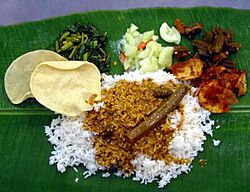Banana leaf platter facts for kids

Banana leaf rice
|
|
| Place of origin | India |
|---|---|
| Region or state | South India Southeast Asia |
| Main ingredients | Rice, curry, banana leaf |
Banana leaf rice is a special way of serving food, especially rice dishes, that comes from South India. It's a very old tradition! Because many people from South India have moved to other countries, you can also find banana leaf rice in places like Malaysia and Singapore.
Contents
What is Banana Leaf Rice?
The Special Plate
When you have a banana leaf meal, your food is served on a big, fresh banana leaf instead of a regular plate. This leaf is not eaten; it's just a natural, disposable plate! People use banana leaves because they are large and grow everywhere in South India.
What's on the Leaf?
Usually, white rice is placed in the middle of the leaf. Around the rice, you'll find different kinds of yummy side dishes. These often include various cooked vegetables, pickles (which are tangy and spicy), and crispy appalam (a thin, crunchy cracker). There are also other small dishes that can be sour, salty, or spicy.
Traditionally, banana leaf meals are vegetarian. This means they usually come with vegetarian gravies, like a tasty soup called sambar. However, sometimes you might find other things added, like boiled eggs, or even curried or fried meat and seafood.
How Many Servings?
Often, you get two servings of rice. The first serving comes with all the gravies, side dishes, and condiments. The second serving is usually just rice with curd (which is like yogurt). The curd helps to clean your taste buds after all the spicy food.
How to Eat Banana Leaf Rice
Eating with Your Hands
Banana leaf meals are traditionally eaten with your hands. It's a special part of the experience! People usually use only their right hand. You should only use the tips of your fingers to pick up the food. It's considered polite not to let the food touch past your first knuckle or your palm.
Folding the Leaf
After you finish your meal, there's a special way to fold the banana leaf. This is a sign of good manners and respect.
- If you fold the leaf inwards (towards you), it means you are thankful to the person who served you the meal. This is what you should always do when you are a guest or eating at a restaurant.
- However, if you are at a funeral, people fold the leaf outwards (away from you). This shows sadness and respect for the family of the person who passed away. Because of this, folding the leaf outwards at any other time is considered rude.

